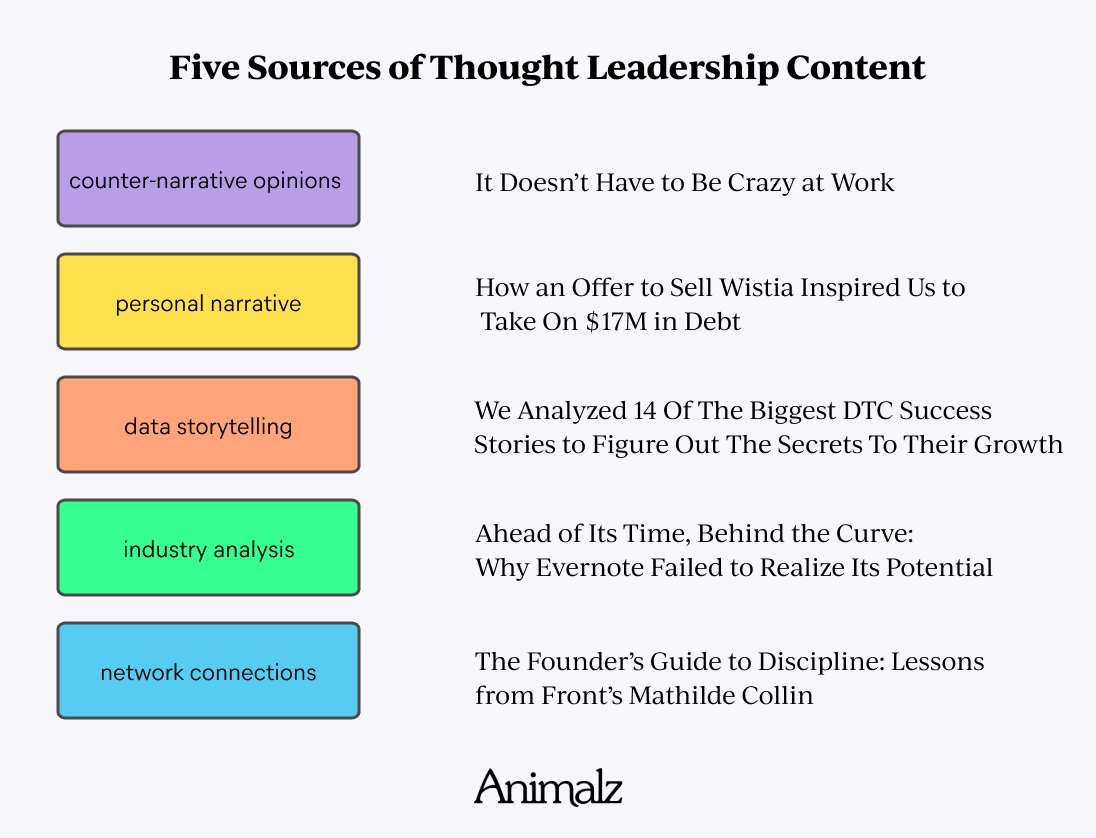
5 Ways to Write Better Blog Post Titles - Animalz
5 Ways to Write Better Blog Post Titles
Writing titles for blog posts is hard because it requires a different type of thinking than you use for general writing.
When you finish writing an article, you understand the topic you’ve just written about at a deeper level than ever before. You’ve just spent hours/days/weeks organizing your thoughts into words. You can speak eloquently on the topic.
To come up with a good title for that piece, however, you need to find a framing of the topic that will make sense and interest someone who knows none of what you now know. You have to think like a complete beginner—go back in time to before you understood everything you understand now.
One of the best ways to go back in time is to use a collection of mental models to put yourself in a different frame of mind. With the right mental toolset, you can help your brain snap out of “expert mode” and into that fruitful beginner mode much faster.
1. Help Your Readers Get Promoted
Your readers have needs. They want raises and promotions. They want to look good at work. Great title-writers take advantage of those needs without being manipulative or condescending to their reader.
The top headlines from a site like Inc. are a good example of how far this can be taken if your #1 goal is to drive clicks. Almost every article on Inc. plays on some volatile cocktail of emotions, whether it's:
- laziness (the desire to get more with less effort),
- self-righteousness (the desire to get what we feel we truly deserve), or
- schadenfreude (and the desire for others to get what they deserve).
Relying strictly on this kind of emotional manipulation is unlikely to be appropriate if you're creating content for, say, a video marketing product.
That doesn't mean you can't address a work-related emotional need more relevant to your customer base, the way Wistia does, for example, with a post like Look Great in your Next Webcam Video.
People want to look good to their bosses, be better at their jobs and be recognized. They want to look good on camera and sound more confident on sales calls. They want to get more done in less time, have better relationships with their coworkers and be less distracted.
Frame your piece of content around the "need" it's addressing, and your titles will be crisper, more relevant and more effective.
This holds even if you're writing about something as technical and specific as using behavioral cohorts in your product analytics strategy. The #1 goal for most PMs is figuring out how to retain users. That's the need that occupies most of their time at work. It makes sense to help them with content and to make it clear in the title just how vital your advice is:
The writing process here is relatively simple.
Figure out what desirable result your piece of content is going to help readers achieve or what emotional fulfillment it's going to deliver. Then orient your title around that.
If it's not helping anyone in your specific audience get better at something they want to get better at, what's the point of writing it?
2. Reverse Everyday Expectations
Counterintuitive titles make us click because they present the world in a way we don't expect. We click because we're curious about how this new worldview works.
The key to a counterintuitive title is really understanding your space. You have to understand what unstated assumptions guide the plurality's thinking. Then you have to know, very specifically, how to frame a contrarian take.
Opting to "go slow" when your competition "accelerates," for example, goes so against the conventional ideas we have about startup competition—most of which are informed by the logic of venture capital and fast growth—that you feel compelled to click just to figure out the argument the author, Chris Savage, is making.
Put yourself in your reader's shoes. Ask, "Why would this article be interesting to read for me?" Use that to find your angle.
3. Show Your Work in the Title
Some articles are easy to write titles for. All you have to do is own the actual value you're delivering and be slightly immodest about showing it off.
Sometimes, demonstrating the value that you're delivering to the reader means making explicit the work that went into producing the piece of content. You can study a bevy of post-welcome email examples for an article about what makes a great post-welcome email and then call it, "10 Tips for a Better Post-Welcome Email," but—assuming you actually put some effort into your analysis—this is a dramatic undersell.
Calling it "Lessons from an Epic Analysis of 50 Welcome Emails," on the other hand, makes me feel like I am getting the result of some serious thinking and study on the subject of post-welcome emails. It makes me feel like I'm going to get something of real value, and that makes me want to click.
"Showing your work in the title" like this can be a powerful way to reset your title when you feel like you've put a lot of work into your content and it's just not coming through in the title.
Try retracing your steps to find a process-based title you can put on your piece instead.
4. Mine the Specific for Universal Truths
With workaday SaaS content, there may not be an obvious counterintuitive or effort-based angle that you put to work in the title.
In these situations, the best thing to do is just take the most obvious title you can possibly imagine for your piece and turn the screw a few rotations in your mind. Try to find the most explicit embodiment of your piece, then go a few steps further, find something more specific to pull out, and see what happens.
First, imagine you title your post on Facebook ads "8 Psychological Tips for Making Your Facebook Ads More Powerful."
It has the basic cadence of a title. It's not blowing anyone away, and it sounds fairly generic, but it gets at the point of the article in a clear way.
If you go deeper, though, you can look for things that do make your article different from others like it. Are there points made that stand out? Are there novel bits of your article that could make the title work better? Or could you include a learning in the title itself?
Often, it's those specific details that make a piece interesting to a wide audience — not the more general, generic formulation. We always find the universal in the specific, not in the outwardly universal, and you can use the same phenomenon in your blog post titles to make your content more interesting.
5. Get Out of the Story's Way
Sometimes a number (like a conversion rate) or a name (like Amazon) is the real story behind what you're writing, and your job as a title-writer is mainly to get out of the way.
Make yourself scarce. Allow the title to speak for itself.
This is a great way to go because generally, the easiest way to make whatever you're writing about interesting is to appeal to remarkable numbers ("How One Line of Code Increased our Conversion Rate 25%") and remarkable names ("Why Amazon's Best Managers Aren't The Ones Who Went to Ivy League Schools").
Numbers and names give us something powerful to hang our arguments on: proof.
More importantly, they make us curious about:
- how particular people accomplished remarkable things
- how remarkable people do particular things
If you can mention the percentage point improvement that a decision resulted in, or the name of a major company, you almost always should.
It's not always necessary to pull out a perfect percentage point number, either. Just evoking the quantitative aspect of your story can be an effective way to leverage that love of proof.
We might not care that Booking.com does a lot of A/B tests because if we know anything about A/B tests, we know that a lot of companies do a lot of A/B tests.
When we're given the precise figure, on the other hand, we get a perspective on the scale of the situation, and that's a story. Nothing about the actual article needs to have changed, but readers are far more interested to know how this presumably massive testing suite could possibly work.
It works similarly with the names of prominent companies that, depending on where you're writing, people inherently care about.
When you write a post about how Amazon or another major company does something — especially if it goes against the way we think — people will be interested before you even put any effort in.
It's the perfect way of letting your article ride off the inherent curiosity we have about how the biggest and best companies do things differently.
You shouldn't, however, namedrop for the sake of namedropping.
The reason that "Why Amazon's Best Managers Aren't The Ones Who Went to Ivy League Schools" would work as a title isn't just that it mentions Amazon. It's that it uses the idea of Amazon to play upon one of our strongest emotional biases: undeserved privilege.
Why Writers Should Think About Titles
It would be a mistake for writers to leave the work of coming up with and picking a title solely to their editors.
Picking a title is just as much an exercise in thinking about distribution and framing as it is an exercise in thinking about what is truly interesting about your post.
Whatever tactic you choose, in the end, this is what coming up with a title is about: finding the perspective, angle, frame, or simple combination of words that makes the prospect of reading your article interesting to someone who 1) knows nothing about it and 2) has no obligation whatsoever to read it.










